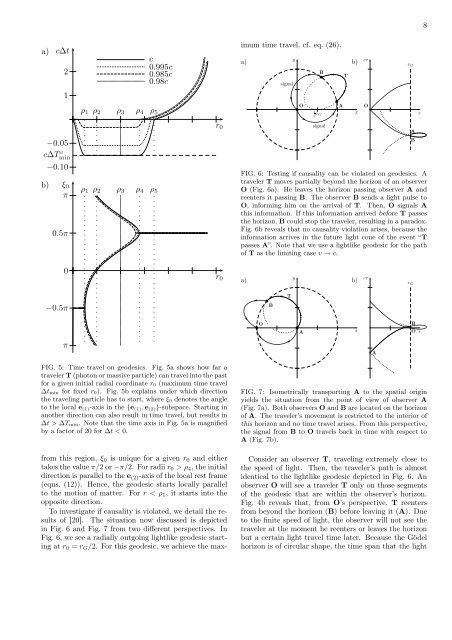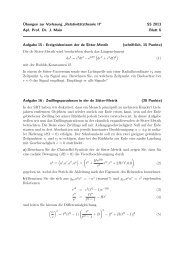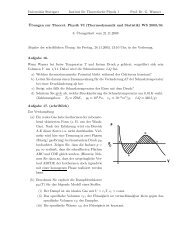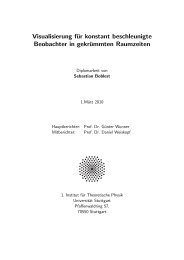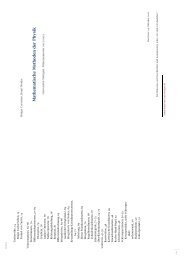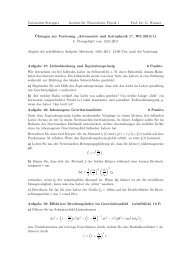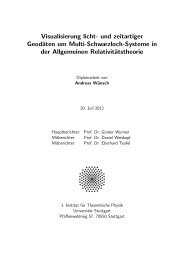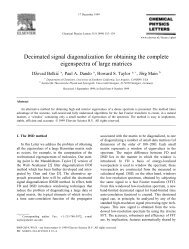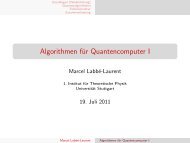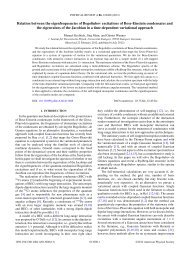The Gödel universe - Institut für Theoretische Physik der Universität ...
The Gödel universe - Institut für Theoretische Physik der Universität ...
The Gödel universe - Institut für Theoretische Physik der Universität ...
Create successful ePaper yourself
Turn your PDF publications into a flip-book with our unique Google optimized e-Paper software.
a)<br />
c∆t<br />
c∆T c min<br />
b)<br />
2<br />
1<br />
−0.05<br />
−0.10<br />
ξ0<br />
π<br />
0.5π<br />
0<br />
−0.5π<br />
π<br />
ρ1 ρ2 ρ3 ρ4 ρ5<br />
ρ1 ρ2 ρ3 ρ4 ρ5<br />
c<br />
0.995c<br />
0.985c<br />
0.98c<br />
FIG. 5: Time travel on geodesics. Fig. 5a shows how far a<br />
traveler T (photon or massive particle) can travel into the past<br />
for a given initial radial coordinate r0 (maximum time travel<br />
∆tmin for fixed r0). Fig. 5b explains un<strong>der</strong> which direction<br />
the traveling particle has to start, where ξ0 denotes the angle<br />
to the local e(1)-axis in the {e(1),e(2)}-subspace. Starting in<br />
another direction can also result in time travel, but results in<br />
∆t > ∆Tmin. Note that the time axis in Fig. 5a is magnified<br />
by a factor of 20 for ∆t < 0.<br />
from this region, ξ0 is unique for a given r0 and either<br />
takes the value π/2 or −π/2. For radii r0 > ρ4, the initial<br />
direction is parallel to the e (2)-axis of the local rest frame<br />
(eqns. (12)). Hence, the geodesic starts locally parallel<br />
to the motion of matter. For r < ρ1, it starts into the<br />
opposite direction.<br />
To investigate if causality is violated, we detail the results<br />
of [20]. <strong>The</strong> situation now discussed is depicted<br />
in Fig. 6 and Fig. 7 from two different perspectives. In<br />
Fig. 6, we see a radially outgoing lightlike geodesic starting<br />
at r0 = rG/2. For this geodesic, we achieve the max-<br />
r0<br />
r0<br />
imum time travel, cf. eq. (26).<br />
a)<br />
signal<br />
y<br />
B<br />
O A<br />
1<br />
2 rG<br />
signal<br />
FIG. 6: Testing if causality can be violated on geodesics. A<br />
traveler T moves partially beyond the horizon of an observer<br />
O (Fig. 6a). He leaves the horizon passing observer A and<br />
reenters it passing B. <strong>The</strong> observer B sends a light pulse to<br />
O, informing him on the arrival of T. <strong>The</strong>n, O signals A<br />
this information. If this information arrived before T passes<br />
the horizon, B could stop the traveler, resulting in a paradox.<br />
Fig. 6b reveals that no causality violation arises, because the<br />
information arrives in the future light cone of the event “T<br />
passes A”. Note that we use a lightlike geodesic for the path<br />
of T as the limiting case v → c.<br />
T<br />
b)<br />
y<br />
a) b)<br />
O<br />
B<br />
T<br />
A<br />
x<br />
x<br />
cτ<br />
O<br />
cτ<br />
A<br />
rG<br />
A<br />
B<br />
rG<br />
B<br />
r<br />
O r<br />
FIG. 7: Isometrically transporting A to the spatial origin<br />
yields the situation from the point of view of observer A<br />
(Fig. 7a). Both observers O and B are located on the horizon<br />
of A. <strong>The</strong> traveler’s movement is restricted to the interior of<br />
this horizon and no time travel arises. From this perspective,<br />
the signal from B to O travels back in time with respect to<br />
A (Fig. 7b).<br />
Consi<strong>der</strong> an observer T, traveling extremely close to<br />
the speed of light. <strong>The</strong>n, the traveler’s path is almost<br />
identical to the lightlike geodesic depicted in Fig. 6. An<br />
observer O will see a traveler T only on those segments<br />
of the geodesic that are within the observer’s horizon.<br />
Fig. 4b reveals that, from O’s perspective, T reenters<br />
from beyond the horizon (B) before leaving it (A). Due<br />
to the finite speed of light, the observer will not see the<br />
traveler at the moment he reenters or leaves the horizon<br />
but a certain light travel time later. Because the <strong>Gödel</strong><br />
horizon is of circular shape, the time span that the light<br />
8


